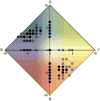Do color appearance judgments interfere with detection of small threshold stimuli?
- PMID: 22330387
- PMCID: PMC3671591
- DOI: 10.1364/JOSAA.29.00A258
Do color appearance judgments interfere with detection of small threshold stimuli?
Abstract
The application of adaptive optics to vision science creates the potential to directly probe the link between the retinal mosaic and visual perception. However, interrogation on a cellular level requires small, threshold stimuli and therefore an implicit detection model. Unfortunately the parameters governing detection at cone threshold are poorly constrained, and whether or not appearance judgments interact with detectability under these conditions is unknown. We tested the assumption that subjects can report stimulus appearance without compromising sensitivity by having four subjects rate either detection certainty, color appearance, or both, for small, brief, monochromatic (580 nm) point stimuli presented to the dark adapted fovea. Reporting color, either alone or in conjunction with detection certainty, did not impair detection. Sensitivity actually increased in the simultaneous reporting task, while color reports were effectively unaltered. These results suggest that 1. color mechanisms contain information relevant for detection at cone threshold, 2. subjects cannot voluntarily make full use of this information in a simple detection task, and 3. simultaneous reporting is a viable method of investigating multiple stimulus attributes for small threshold stimuli.
© 2012 Optical Society of America
Conflict of interest statement
Conflicts of Interest: Darren E. Koenig, None; Heidi J. Hofer, None
Figures








References
-
- Young T. On the theory of light and colours. Phil Trans R Soc Lond. 1802;92:12–48.
-
- Roorda A, Williams DR. The arrangement of the three cone classes in the living human eye. Nature. 1999;387:520–522. - PubMed
-
- Williams DR. Advances in Photoreception: Proceedings of a Symposium on Frontiers of Visual Science. National Academy Press; 1990. The invisible cone mosaic; pp. 135–148. - PubMed
-
- Williams DR, Sekiguchi N, Haake W, Brainard D, Packer O. The cost of trichromacy for spatial vision. In: Valberg A, Lee BB, editors. From Pigments to Perception. Plenum Press; 1991. pp. 11–22.
Publication types
MeSH terms
Grants and funding
LinkOut - more resources
Full Text Sources

